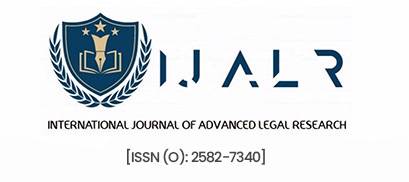Abstract
This study explores the intersection of disability and employment laws in India, focusing on
the legal frameworks that govern the rights and opportunities for persons with disabilities (PWDs) in the workforce. It analyses the historical backdrop, constitutional provisions, and contemporary policies that influence the job environment for persons with disabilities, with the aim of finding-shortcomings in present legislation and proposing enhancements to promote inclusion and empowerment. Notwithstanding legislative advancements, like the Persons with Disabilities Act of 1995 and the Rights of Persons with Disabilities Act of 2016, many individuals continue to meet discrimination and restricted possibilities in the employment sector. This study analyzes the efficacy of existing legislation, examines the socio-economic effects of disability on employment, and suggests methods to promote inclusive workplaces. A historical analysis shows a transformation in society attitudes toward disability from antiquity to contemporary times, highlighting the progression of legal acknowledgment. The efficacy of judicial interpretations of this legislation is also examined. The study examines policies intended to promote work opportunities for persons with disabilities, analyzing state efforts and governmental programs aimed at boosting career chances. Programs like the National Handicapped Finance and Development Corporation are evaluated for their efficacy in helping economic rehabilitation. This study aims to enhance comprehension of disability and employment regulations in India, promoting a legal framework that facilitates the complete inclusion of differently abled individuals in the workforce.
Keywords: Rights of Persons with Disabilities Act, Disability Rights, Categories of Disability.
Introduction
“Every constitution has a philosophy of its own. The philosophical basis of the Indian nconstitution could be traced far back since freedom struggle. Mahatma Gandhi who led the national movement was inspired by the liberal and Christian ideas, vedanta philosophy and novel teachings of Tolstoy.”
He possessed a profound and inscrutable compassion for the marginalized and vulnerable segments of society. His speech clearly indicates that for humanity to advance and achieve the ideals of equality and brotherhood, it must embrace and implement the principle of inclusivity, ensuring that even the mute, the hearing-impaired, and the physically disabled are included. His beliefs, including non-violence (Ahimsa), truth (Satya), simplicity, and secularism, constituted the foundation of the movement. Additionally, socialism, communism, individuality, and idealism significantly influenced the Indian populace and motivated them during the liberation movement.
The study of the constitutional framework is essential, as statutes derive their legitimacy from the constitution. Disability jurisprudence in India emerged in the form of statutory law only after 1995. Until that time, individuals with disabilities were safeguarded under the provisions of the Constitution of India. The Constitution’s framers preferred to establish overarching concepts regarding the State, as these principles delineated the fundamental objectives that every Government should endeavor to attain. A particular emphasis should be placed on the Preamble. Although it does not explicitly mention any group or individuals, its aim is to promote social, political, and economic fairness. The Preamble, therefore, addresses the concerns of those with disabilities to a significant extent in generic terms.

